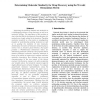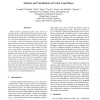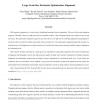BIBE
2006
IEEE
14 years 9 months ago
2006
IEEE
Bioinformatics data is growing at a phenomenal rate. Besides the exponential growth of individual databases, the number of data depositories is increasing too. Because of the comp...
BIBE
2006
IEEE
14 years 9 months ago
2006
IEEE
Discerning the similarity between two molecules is a challenging problem in drug discovery as well as in molecular biology. The importance of this problem is due to the fact that ...
BIBE
2006
IEEE
14 years 9 months ago
2006
IEEE
— Biological networks are formalized summaries of our knowledge about interactions among biological system components, like genes, proteins, or metabolites. From their global top...
BIBE
2006
IEEE
14 years 9 months ago
2006
IEEE
BIBE
2006
IEEE
14 years 9 months ago
2006
IEEE
We show how chemical background knowledge can be used to improve the prediction performance in structureactivitity relationships (SARs) for non-congeneric compounds. The goal of t...
BIBE
2006
IEEE
14 years 9 months ago
2006
IEEE
While genomic sequencing projects have proved an abundant source of information for biological studies ranging from the molecular to the ecological in scale, much of the informati...
BIBE
2006
IEEE
14 years 9 months ago
2006
IEEE
Ribonucleic acid (RNA) molecules contain the genetic information that regulates the functions of organisms. Given two different molecules, a preserved function corresponds to a pr...
BIBE
2006
IEEE
14 years 9 months ago
2006
IEEE
The analysis of alignments of functionally equivalent proteins can reveal regularities such as correlated positions or residue patterns which are important to ensure a specific f...
BIBE
2006
IEEE
14 years 9 months ago
2006
IEEE
BIBE
2006
IEEE
14 years 9 months ago
2006
IEEE
DNA sequence alignment is a critical step in identifying homology between organisms. The most widely used alignment program, ClustalW, is known to suffer from the local minima pro...






